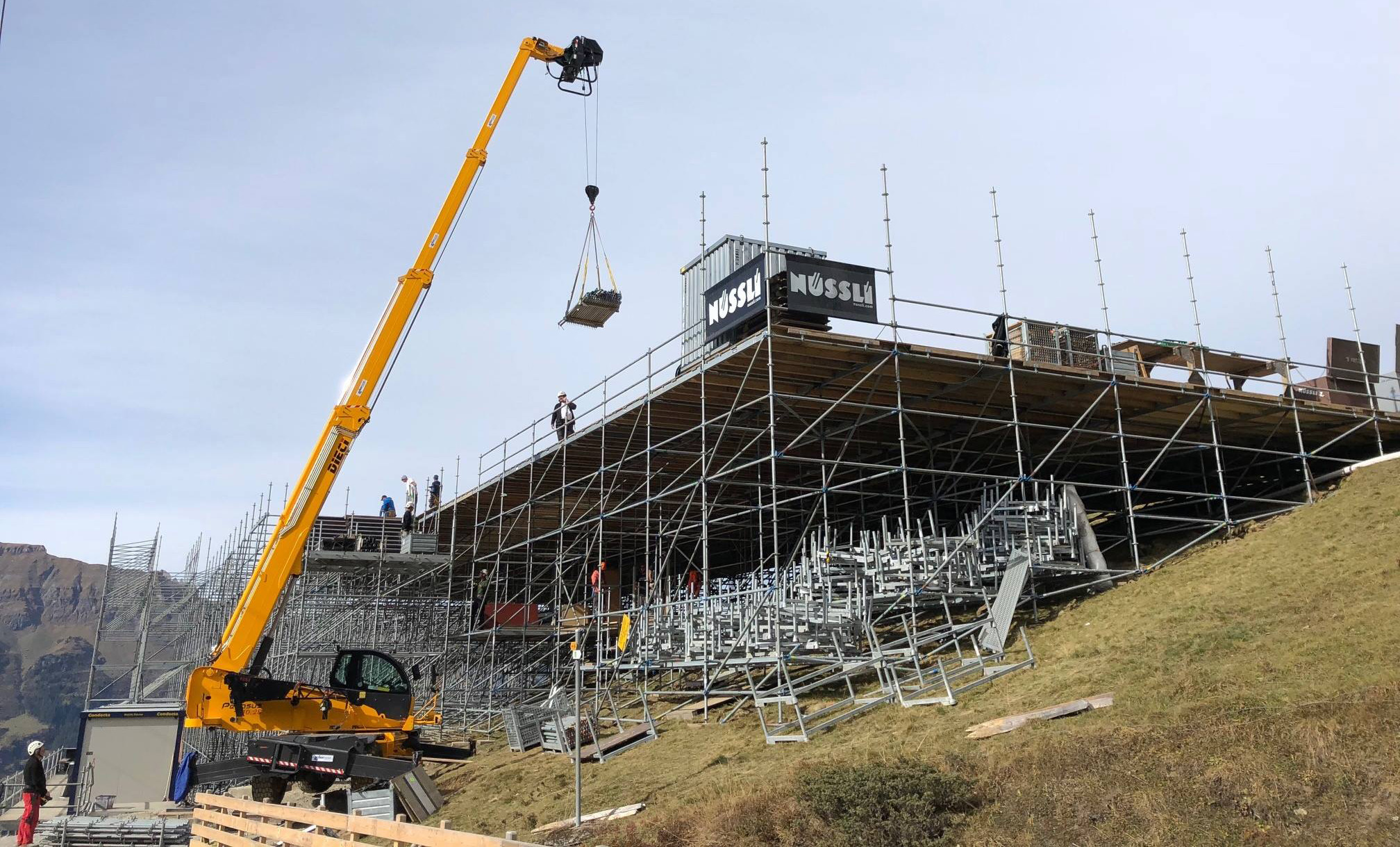Every year, Wengen in Switzerland hosts the Lauberhornrennen, one of the most prestigious races in the World Ski Championship.
For the 2019 Championship, the building of the VIP grandstand was entrusted to the Nüssli Group, a company specialising in the construction of temporary structures for major international events.
For the Lauberhornrennen, Nüssli successfully used our Pegasus 40.25 construction telehandler in place of a conventional crane, thereby improving its productivity in various ways.
The VIP grandstand is an impressive structure weighing 150 tonnes, measuring 22 metres high, 70 metres long and 23 metres wide, and seating up to 570 people. It is located next to the piste, right next to the station where the cogwheel train arrives: a position that further complicates the assemblers’ job, together with the sloping terrain, limited space, widely fluctuating temperatures, unpredictable weather and pressure to deliver a good job within a short time frame.
A rotary telehandler for difficult working conditions
The large incline was no problem for the Pegasus, which is equipped with an excellent self-levelling system, adaptive loading software and an anti-crash system, all of which eliminated the risks caused by the tricky ground conditions.
The large size of the structure and the limited available space also posed no problems for the vehicle. With its maximum lifting height of 24 metres and 360° continuous rotation, our Pegasus could reach every point of the structure as it took shape, precisely and delicately depositing loads up to 4000 kg wherever they were needed. Not even the unpredictable weather and fluctuating temperatures presented a challenge, at least from a technical point of view: the 105 kW FTP engine responded very well, starting readily even at temperatures far below zero, and the LOAD SENSING hydraulic system was equally reliable.
The issue of comfort was slightly more complex, however, as unfortunately only one operator at a time could escape the frigid alpine wind by retreating into the spacious, comfortable cabin and enjoying the excellent air conditioning system.

The Pegasus
In this case, the Pegasus 40.25 was supplied by the DIECI dealer for Switzerland: Arbor AG. Its flexibility of use and cutting-edge instrumentation allowed the operators to work risk-free and with total control of the vehicle in every situation, irrespective of effort, load, terrain and speed.
It is equipped with outriggers with automatic levelling function, plus an electronic control system (developed using CANBUS technology) that allow it to operate in any position. Specifically, depending on the supporting surface, the position of the outriggers and the load weight, the system measures in real time the best work and safety parameters by means of thorough diagnostics, affording total control over working conditions.
The accurate and sensitive capacitive joystick with deadman sensor enables the turret rotation speed to be adjusted/reduced, while the automatic reversal system of the controls makes it possible to travel with the turret rotated 180° so as to easily move within narrow working areas.
The PEGASUS series consists of telehandlers (with either non-continuous or 360° continuous rotation) characterised by extreme flexibility of use. They can be fitted with many different types of accessories to adapt them to many tasks, so a single vehicle can operate as telehandler, aerial platform and a crane.
DIECI in the world: the White Circus
The landscape of Wengen is breath-taking: the dazzling reflecting off the snow, the faces of the Jungfrau and Eiger mountains that seem to blend into a cobalt blue sky, and the Lauberhorn piste that has welcomed skiing enthusiasts since 1930.
DIECI vehicles work around the world, proving themselves to be the most effective solution to diverse problems. In this case, the Pegasus 40.25 telescopic handler replaced a crane in preparations for one of the most important races of the skiing calendar, in extremely arduous working conditions.
Preparations for holding races on the slopes of the Lauberhorn continue all year round: the organisation of such an event requires a lot of time, patience and work, because everything must be ready, tested and fully functional before the start of the three-day races (held on 18–20 January 2019).
It is difficult to imagine just how much work it takes to prepare for the competition: artificial snow, levelling and packing the pistes, fencing, security systems, kilometres of cables and control units for communications, press rooms, offices, vehicles and rescue points, work teams, material warehouses, catering outlets, public help desks, grandstands and so on.
Around 500 volunteers started working in Wengen to prepare the event since September, but certain jobs require experienced professionals, such as Nüssli, which has already built temporary structures for major events such as the Milan Expo, the Mexican F1 Grand Prix, the Super G in St Moritz, and many others besides.

